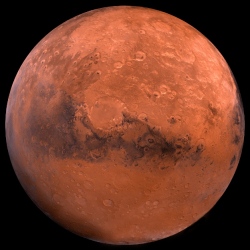
Are there other lifeforms outt here? With so much focus these days on finding new Earth-like exoplanets, we should not overlook the possibiliy of the existance of extra-terestrial life within our own solar system. Here is a rundown of the location where we might find life:
Mars
Sure, we’ve been hunting life here for decades, but we may have been going about it the wrong way. Anything alive today probably lives deep underground, protected from radiation and temperature extremes; it might resemble deep, electrically active microbes on Earth. To look for Mars life: Drill, baby, drill!
Europa
At its heart, this large Jovian satellite (at 1,940 miles wide, a smidge smaller than our own) has an extensive ocean and possible undersea volcanoes. On occasion, water bursts from Europa’s cracked, icy surface in large plumes. The proposed Europa Clipper spacecraft would investigate whether its conditions are conducive to life.
Titan
Saturn’s largest moon has a thick, methane-tinged atmosphere and lakes of liquid hydrocarbons, which could support a version of the organic chemistry that preceded life on our planet. Temperatures here are too low for any known kind of biology, although asteroid impacts might create temporary oases…and life is full of surprises.
Enceladus
Saturn’s 300-mile-wide moon Enceladus is stretched and squeezed by gravitational interaction with its neighbors. The resulting friction heats its interior, and may power a system of hydrothermal vents below its south pole; such vents would be natural homes to rock-breathing microbes.
Ceres
The largest member of the asteroid belt is covered with clays and carbon-bearing minerals, resembling the carbon-rich meteorites that rained down on the early Earth. In March, NASA’s Dawn spacecraft will begin an extended study of Ceres; it isn’t equipped to look for life but could test for favorable chemistry on the surface.
Ganymede
Orbiting Jupiter just beyond Europa, the giant moon Ganymede, bigger than the planet Mercury, looks rather inert on the outside, but it may be warm and active within. The European JUICE mission, set for launch in 2022, will reveal more about Ganymede’s makeup, and will carry out studies of Europa, too.
Mimas
Like its cousin Enceladus, this small Saturnian moon is an ice ball that is heated by a tug-of-war with other, nearby satellites. Recent studies indicate that Mimas could be partly melted inside. Anywhere that water meets rock, even dozens of miles down, there is chemical energy available that could potentially power life.
Triton
Neptune’s giant moon orbits backward, opposite the direction of the planet’s rotation, probably because it was captured when it passed too close millions of years ago. That wrenching event must have melted its icy interior; Triton is -390°F on the surface but might still have a warm, wet layer near its core.
Pluto
Life on Pluto? Not as crazy as it sounds. Long ago, Pluto was energized by a giant impact that created its moon Charon, and it probably melted in the process. There could still be an aquifer of some sort locked away inside. The New Horizons probe will fly past Pluto in July, carrying seven instruments to scrutinize the dwarf planet.
